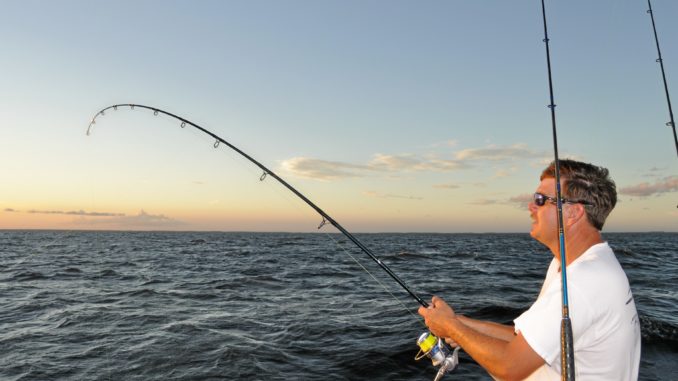
Dark nights, heavy tackle and oyster beds are three keys for catching Pamlico Sound’s ‘old’ drum
Adam Jones may have to re-think the name of his guide service — AJ’s Sea Duck and Trophy Swan Hunts — because it doesn’t hint at what he does during the dog days of July and August.
Each summer, months before duck and swan seasons start, Jones, a 37-year-old from the Hyde County village of Englehard, takes anglers to Pamlico Sound to fish for “old” drum.
From the same family of croaker, spot, black drum, weakfish and spotted seatrout, these gigantic red drum, aka channel bass, are called “old” because they’ve lived long enough — 20 to 50 years — to reach more than 40 inches in length and weigh from 35 to 90 pounds.
When Jones takes anglers fishing for old drum on his 24-foot skiff, they regularly land fish older than they are, and that’s not something many people can say about other inshore saltwater species.
“The best time to fish for old drum in the summer is at night,” Jones said. “People do fish for drum during the day, and they catch ’em, but night is when it’s most comfortable to be out on the sound, and that’s when drum seem to bite the best.”
So each summer evening, boats head out from ports such as Engelhard, Swan Quarter, Belhaven, Hobucken and Oriental for a night of soaking baits in search of old drum on the massive Pamlico Sound. It’s a body of water so large — 80 miles long and 15 to 30 miles wide — the explorer Verazzano mistakenly thought he’d reached the Pacific Ocean when he first saw America’s second-largest estuary.
Jones starts his fishing day in the afternoon because he likes to expose his clients to how his he learned to drum fish, the old-fashioned way.
“First, we’re gonna get some bait,” he said.
Old drum prefer the freshest baits, and for Jones that means setting a gill net to catch jumping mullet. Joined by his fishing buddy, Woody Williamson, an Englehard resident and veteran waterman, they put in at the ramp in Swan Quarter. Jones likes to carry Williamson with him on guide trips because he often needs some help after dark fixing tackle, landing fish, watching lines, tinkering with a balky outboard motor, but his biggest role is helping catch bait with the 100-foot gill net.
Reaching the open sound and turning east, Jones and Williamson looked for mullet jumping near marsh islands. After they spotted several silvery streaks leaping from the water, Jones eased toward the corner of an island and dropped one weighted end of his gill net, while Williamson slowly motored toward another nearby island as Jones let out more net from the stern.
After setting the net, they waited 15 minutes and checked it, grabbing entangled mullet and dropping them into a bucket.
“Drum like fresh bait, and this is the freshest you can get,” Jones said.
After a couple more net sets, Jones had about two dozen mullet, which he poured them into an ice-filled cooler.
“It’s a little early, but we might as well go where I want to fish,” he said. “We’ve got to take our time going out because the wind’s against us, and we can’t go very fast. We can run faster coming back with the wind at our backs.”
Jones had chosen a route that took the boat five miles south, then three miles southwest. Each leg of the trip was either directly into the wind or quartering, into it so waves bounced the skiff.
“I picked this spot because it’s an old oyster reef and has a hard bottom, not sand or soft mud,” Jones said. “Drum like hard bottoms, especially ones with oyster shells.”
Jones’ father has been an oysterman most of his life, and working with him, his son learned the locations of the best oyster reefs on the bottom of Pamlico Sound. Drum frequent oyster reefs because small black crabs (mud crabs) they consider a delicacy live in the shells.
Jones mates a set of 8-foot, Shimano TerraMar and Okuma Cedros CJ65 rods with Ambassadeur baitcasting reels spooled with 30-pound yellow Sufix monofilament.
“The yellow line shows up better at night in the lights, and you can follow where a hooked fish is going,” said Jones, whose terminal tackle included a 3-ounce barrel weight and six inches of 80-pound leader: a basic Owen Lupton drum rig. The rig’s short leader — which helps detect a strike early — prevents drum from swallowing a hook that could later wind up being fatal.
“We must have 9/0 circle hooks, too, with the barb pinched down,” Jones said. “To be legally fishing from 7 p.m. to 7 a.m. you have to use circle hooks because you don’t want to deep-hook drum if you can help it. From 7 a.m. to 7 p.m., J-hooks are legal because people fish other species, such as tarpon, with the same rigs and bait we use for drum.”
Jones and Williamson threaded mullet fillets and heads on the circle hooks, then fan-cast their baits as far from the anchored boat as they could. Four rigs with mullet went off the stern, and two were launched off the bow.
“Now we wait,” Jones said. “If the wind gets up too much and the boat starts bouncing, we’ll have to put a little slack in the lines so the baits won’t be jerked off the bottom.”
Big cow-nosed rays and skates are prolific in the sound, and Jones and his parties often hook them on the same spots and with the same set-ups that produce old drum.
“(Catching skates) isn’t necessarily a bad sign,” he said. “The other night, we caught a dozen skates, then we caught eight drum in a row.
“You never know what’s going to happen. I’ve come here several times the last two weeks with people, and we caught a lot of drum.”
One of Jones’ parties caught 11 fish ranging from 35 to 50 pounds in four hours from the same spot.
“(Old drum) fishing’s like that,” he said. “Sometimes they bite, and sometimes they don’t. But one thing is for sure — you won’t catch anything if you’re not out there.”
The only drawback to fishing at night during July and August can be weather, as thunderstorms often roll across the sound.
“You want to bring a good rainsuit if you’re going to fish for drum at night,” Jones said, “and something that’ll keep any cameras you might have dry — and food, too. You also need one of those small lights that clip on the bill of a cap so you can see.”
However, storms aren’t a concern most summer nights. The chance of getting scared and soaked is probably less than five percent, and a comfortable camp chair and lapping waves can put most anyone to sleep in a rocking boat, especially after midnight if the fishing action is slow.
DESTINATION INFORMATION
HOW TO GET THERE/WHEN TO GO — From Raleigh, follow US 264 east to Greenville, Washington and Belhaven and then to Engelhard. The best times to take big drum in the Pamlico Sound are July and August.
EQUIPMENT/BAIT — Heavy-dut,y 8-foot rods with Ambassadeur baitcasting reels spooled with 30-pound, yellow, high-visibility Sufix line. Terminal tackle should be Owen Lupton drum rigs, which include a 3-ounce barrel weight and 5- to 6-inch leader and 9/0 circle hook with the barb pinched down. Circle hooks are mandatory for old drum night fishing at Pamlico Sound from 7 p.m. to 7 a.m. J hooks may be used from 7 a.m. to 7 p.m. to allow anglers to catch tarpon. The best baits are fresh mullet filets or heads. Many fishermen catch their own bit, but mullet can usually be purchased at tackle shops.
FISHING INFO/GUIDES — Adam Jones, AJ’s Sea Ducks and Trophy Swans Guide Service, 252-943-5932, www.ajseaducksandswans.com. Also, see GUIDES and CHARTERS in Classifieds.
ACCOMMODATIONS — Hotel Engelhard, 34901 U.S. 264, Engelhard, 800-290-5311.
MAPS — Capt. Segull’s Nautical Charts, 888-473-4855, www.captainsegullcharts.com; Sealake Fishing Guides, 1-800-411-0185, www.thegoodspots.com; GMCO’s Chartbook of North Carolina, 888-420-6277 or www.gmcomaps.com.

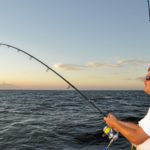
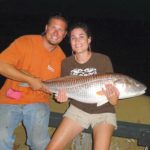
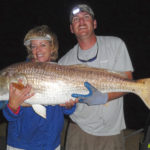
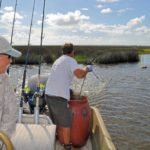

Be the first to comment